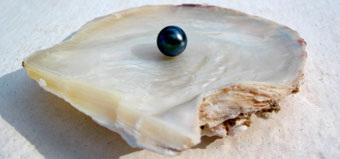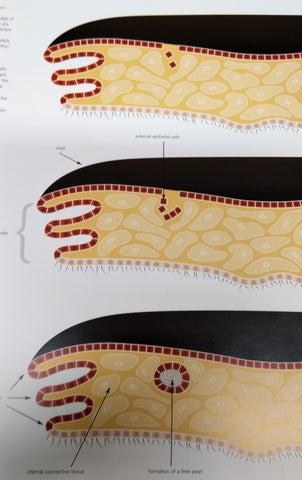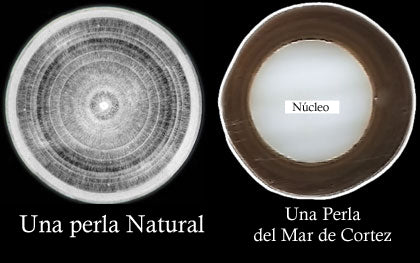How Natural Pearls are Really Created: From the Myth of the Grain of Sand to the reality of the Pearl Sac Theory
Most people believe -or have heard- that a small grain of sand is responsible for the formation of a pearl; so, in order to produce a cultured pearl, you basically just have to get a grain of sand inside the oyster, right?
We read that this was not true, but what if... We had to try, and we did the experiment of putting a spoonful of sand (if a grain of sand made a pearl, a bunch of sand would give hundreds) inside each of the pearl oysters that we kept in fish tanks close to the office. We also left a camera that took pictures every 20 seconds recording the activity.
The following day we found all the sand laying in the bottom of the fish tanks. When we checked the video, it showed that the pearl oysters made strong contractions, and with each contraction they created a jet of water that carried clouds of sand out of their shells until they were perfectly clean.
None of those pearl oyster gave, ever, a natural pearl. We knew the theory, but we still had a little of irrational hope of obtaining, in an easy manner, natural pearls.

Pearl Oysters are well adapted to their environment which means dealing with a lot of sand every time there is a storm. They are capable of getting rid of sand, bits and pieces of shell, corals, and little pebbles. They are perfectly adapted to their watery environment.
The most accepted reason behind the natural formation of a pearl lies behind a biological intruder: a parasitic organism. These may be drill-worms (polychaetes, such as Polydora), drill-mussels (like Teredo) or many other kinds of organisms (like the drill-sponge Cliona). When a parasite drills through the shell of the pearl oyster, the oyster starts its defensive mechanisms and uses its MANTLE to form a barrier.

The Mantle is a unique secretory organ that covers all the inside of the shell of the oyster and is responsible for the secretion of the pearly substance known as mother-of-pearl or nacre. The oyster will use its mantle to secrete nacre on top of these nasty intruders and, if lucky, will coat them and turn them into natural pearls. Very few natural pearls will be of good size (bigger than 8 mm) and of good quality, and those that do are able to fetch very high prices.
A pearl oyster (like the Pinctada mazatlanica) can secrete 3 or 4 concentric layers of nacre each day. These layers measure an average of a thousand part of one millimeter (or, one micron), so they are very thin. It will take an oyster at least two years just to create a natural pearl with a size of 3-5 mm.
Graphical Explanation of the Pearl Sac Theory in Action: Natural vs Cultured Pearls
The graphic below (used with the permission of Hubert Bari & David Lam, from their beautiful book "Pearls") is a representation of the mother-of-pearl shell (in blue) and the mantle tissue in the oyster (represented by the gray bar between the red colored "cells") as it forms the pearl. The parasite is represented as a dark red spot. What happens here is that the parasite drills through the shell, it is covered by the nacre secreting cells of the mantle, and finally becomes "engulfed" within the mantle, where it begins to grow... this is the birth of the pearl.

Cultured pearls, on the other hand, are formed not when an intruder "attacks" the oyster, but when a specialized technician places a small sphere of mother-of-pearl shell (most of these come from freshwater mussels that are harvested from the waters of the Mississippi river in the United States) and a small piece of mantle tissue (the "graft") are put together inside a pearl oyster's gonad. This may seem a very different procedure, but the basis is exactly the same as the one depicted above.

The striped circle in this diagram represents the shell nucleus (the bead or core) and the small thing attached to it represents the "graft" or piece of mantle tissue. Surrounding these is the pearl oyster's gonad tissue. In a few days the piece of mantle tissue will partially degenerate, but the nacre producing (epithelial) cells will start growing around the bead. Later it will start the secretion of nacre, and the cultured pearl will start growing.
So, this is how actual pearls are created or born unto the world...some would wish it was a grain of sand, but Life is usually far more interesting and astounding.

